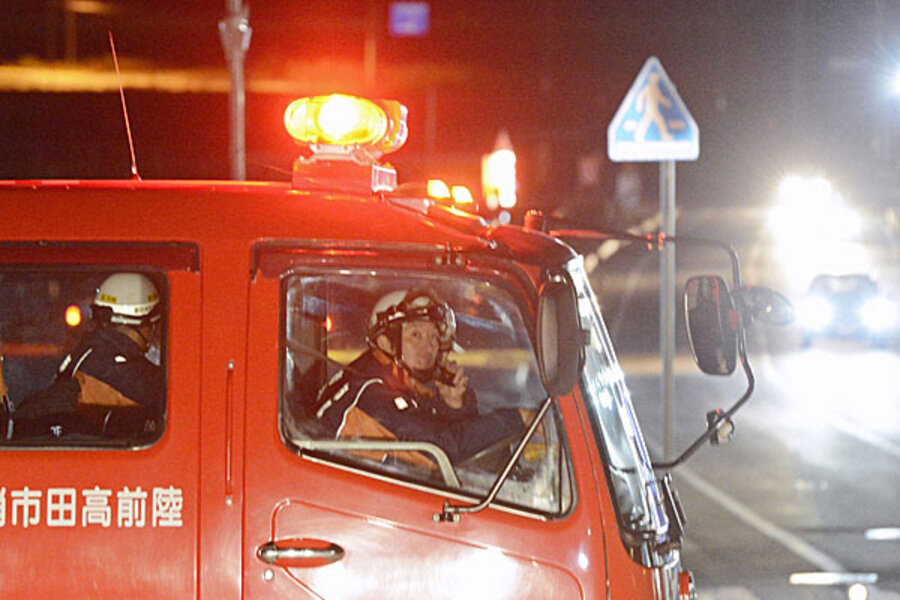Tsunami warning lifted after 7.3 earthquake shakes Japan
Loading...
| TOKYO
A strong earthquake Friday struck the same Japanese coast devastated by last year's massive quake and tsunami, generating small waves but no immediate reports of heavy damage. Several people along the northeastern coast were reportedly injured and buildings in Tokyo and elsewhere swayed for several minutes.
The earthquake had a preliminary magnitude of 7.3 and struck in the Pacific Ocean off the coast of Miyagi prefecture at 5:18 p.m. (0818 GMT), the Japan Meteorological Agency said. The epicenter was 10 kilometers (6.2 miles) beneath the seabed and 240 kilometers (150 miles) offshore.
The area was shaken by repeated, smaller aftershocks, the agency said. (Read more about how the Fukushima disaster affected the fishing industry)
After the quake, authorities issued a warning that a tsunami potentially as high as 2 meters (2.2 yards) could hit. Sirens whooped along the coast as people ran for higher ground.
Ishinomaki, a city in Miyagi, reported a tsunami 1 meter (1 yard) high and other towns reported smaller tsunamis.
About two hours after the quake struck, the tsunami warning was cancelled. The Pacific Tsunami Warning Center earlier said there was no risk of a widespread tsunami.
Aiko Hibiya, a volunteer for the recovery in Minami-Sanriku, a coastal town devastated by last year's tsunami, said she was at a friend's temporary housing when the quake struck.
"It shook for such a long time," she said.
She said other volunteers who had been in coastal areas were evacuated to a square and a parking lot as they waited for the tsunami warning to be lifted.
Japan has barely begun to rebuild from last year's magnitude- 9.0 earthquake, which triggered a tsunami that swelled to 20 meters high in some areas, ravaging dozens of coastal communities in Miyagi and elsewhere. About 19,000 people were killed and some 325,000 people remain displaced from their homes, living in barracks and other temporary quarters. (Read the Monitor's report on that here)
Miyagi prefectural police said there were no immediate reports of damage from Friday's quake and tsunami, although traffic was being stopped in some places to check on roads.
Public television broadcaster NHK reported that five people were injured, including a 75-year-old woman in Miyagi who fell while fleeing the tsunami. Police said they could not immediately confirm those reports.
Shortly before the earthquake struck, NHK broke off regular programming to warn that a strong quake was due to hit. Afterward, the announcer repeatedly urged all near the coast to flee to higher ground.
The Meteorological Agency has an early warning system that, using data from seismographs scattered across Japan, enables it to provide advance warning of the estimated intensity and timing of a major quake. The warning for Friday's quake was issued six minutes before it struck, according to an unnamed official from the Meteorological Agency who spoke on national television more than an hour after the quake.
The magnitude-9.0 earthquake and ensuing tsunami that slammed into northeastern Japan on March 11, 2011, killed or left missing some 19,000 people, devastating much of the coast. (Read more about Japan one year after the disaster here)
Last year's earthquake and tsunami also caused meltdowns at the Fukushima Daiichi nuclear plant in the worst nuclear disaster since the Chernobyl in 1986.
Immediately following Friday's quake, there were no problems at any of the nuclear plants operated by Fukushima Daiichi operator Tokyo Electric Power Co., said a TEPCO spokesman, Takeo Iwamoto. Only two of Japan's 50 nuclear plants are currently operating; the rest have been shut down for maintenance and safety checks while the country re-examines the future of nuclear power there.
All Nippon Airways spokesman Takuya Taniguchi said government officials were checking on the runways at Sendai airport. The two jets that were in the air went to other airports and all seven flights scheduled to go to Sendai for the day were cancelled, he said.
Associated Press writer Yuri Kageyama contributed to this report.





